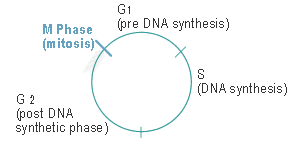Four Basic Radiation Types
Factors affecting damage to cells
- Cell Damage Factors 1
- Cell Damage Factors 2
The following factors affect the damage caused to cells by radiation:
- The type of radiation: The higher the LET (linear energy transfer) of the radiation the more damaging the ionisation is. ( alpha particles have a high LET, beta particles and gamma / X rays have the lowest LET - LET measures the ‘ionisation event density’ along the track). This means there is more biological damage per Gray of absorbed dose received - this is the reason we introduced the term equivalent dose in an earlier part of this course.
- Dose rate: if the radiation exposure is spread over days or months instead of minutes, the DNA breaks may be able to be repaired. This means that the low dose rate (by this I mean protracted or chronic exposure) radiation exposure is not as damaging as an acute exposure. Reducing the dose rate modifies the quadratic but not the linear component of the cell killing.
- Fractionation: as above, this effect results in a high dose being required to give the same effect. In treating cancer this effect is used to advantage as normal cells may recover whereas cancerous cells do not recover so well and the malignant / normal tissue damage is enhanced.
- Stage of cell cycle: Those cells in the G2 and mitotic phase are more sensitive than those in the S phase. This is because these stages in the cell cycle reflect whether there is time after exposure to repair to occur prior division / replication of DNA.


The radio-sensitivity of a tissue is directly proportional to its mitotic activity and inversely proportional to its state of differentiation. It is the process of mitosis that is radiosensitive and it is this that results in the sensitivity of rapidly dividing populations such as the skin, bone marrow and the gonads.
Conversely the brain, muscles, kidney and liver are radio-resistant. Normal tissue benefits from a fractionated dose as being more ‘late responding’ the tissue is spared from the harmful effects.